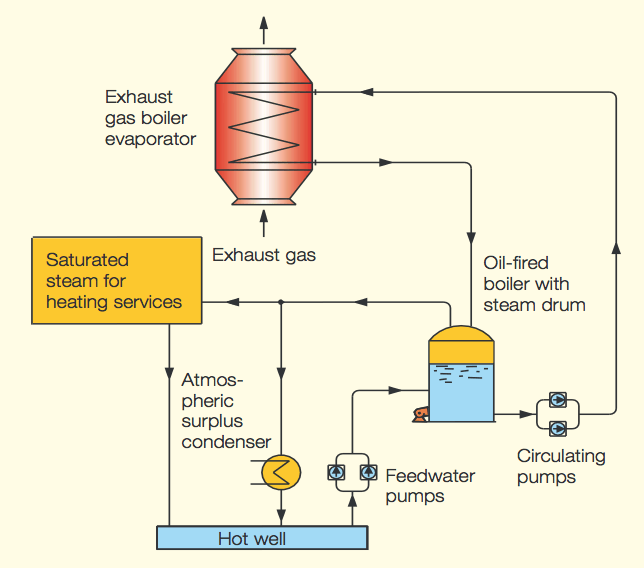An Exhaust Gas Boiler is a type of heat recovering system on ships which allows the exhaust heat of the main engine to produce steam while going out in the atmosphere.
Every system, which is operated at high temperature, always has a risk of fire. This applies to EGB which has the inlet temperature of exhaust gases @ 300-400 deg. C.
The most common type of Exhaust Gas Boiler (EGB) used on ships are water tube boilers.
In water tube type of arrangement, the water passes through tube stack, which is arranged in the path of exhaust gas inside the exhaust gas trunking of the main engine. The exhaust gas flows over the tube stacks and heats the water, thus producing steam.

The main constituent of the soot deposit is particulates but in addition, some unburnt residues of fuel and lubricating oils may be deposited in the boiler.
Soot deposit and fire in the EGB can be-
- Due to the poor combustion of fuel in the main engine
- Due to prolong slow steaming
- Long maneuvering of the ship
- Frequent starting and stopping of the engine
- Poor grade of fuel oil/ cylinder oil
- Low exhaust gas velocity passing the EGB
- Low water inlet velocity in the water tubes
- Low circulation water flow ratio
Types of Exhaust Gas / Soot fire in the Exhaust Gas Boiler (EGB)
For a better understanding, it is better to distinguish the EGB fire in stages rather than in types. EGB fires can be differentiated in two or three stages depending upon the intensity of the fire.
Stage 1: Normal Soot fire
Stage 2: Hydrogen Fire
Stage 3: Iron Fire
Stage 1: Normal Soot Fire:
Soot is deposited in the water tube of the exhaust boiler. When the ship is at slow speed, the exhaust temperature of the main engine may vary from 100 to 200 deg C. This temperature is enough to ignite “wet soot” whose ignition temperature is around 150 deg. C.
If the soot is “dry”, it will not get ignited at such low temperature (150 deg. C) but when the engine is running at higher speed and the temperature of gases reaches to above 300 deg. C, then in the presence of excess oxygen the deposits of combustible materials will liberate sufficient vapor, which can be ignited by a spark or a flame.
The above soot fires are called small or normal soot fire because the heat energy is conducted away by the circulating boiler water and steam. Also, the sparks remain inside the funnel or diminish while passing through the flame arrestor in the funnel top.
Stage 2: Hydrogen Fire
Hydrogen fire in an EGB occurs when the chemical reaction of dissociation of water takes place at a temperature above 1000 deg. C. This leads to the formation of Hydrogen (H2) and Carbon mono-oxide (CO) which are both combustible in nature.
2H2O= 2H2 + O2 (Dissociation of water Leading to formation of hydrogen-H2)
H 2 O + C =H 2 + CO (Reaction of water with carbon deposit leading to formation of carbon monoxide-CO)
Stage 3: Iron Fire
At this stage, the chain reaction of oxidation of iron metal starts at a high temperature of 1100 deg. C which means at such high temperature the tube will start burning itself, leading to complete meltdown of tube stacks.
2Fe + O2 2=FeO+ heat
It is strictly advised not to use water or steam at this stage to fight the fire because the overheated iron will react with water to continue this reaction.
Fe + H2O =FeO+ H2 + heat
Steps for Prevention of Fire
- Avoid slow steaming of the main engine
- Ensure good fuel combustion in the main engine
- Ensure fuel is treated and is of good quality while supplying to the engine
- Do regular soot blow of boiler tubes
- Do water washing in ports at regular interval
- Ensure design of exhaust trunk to be such to provide uniform heat to complete tube stack
- Pre-heated circulating water to be supplied to boiler mainly at the time of startup
- Circulating pump should not be turn off at any time while the main engine is running
- Do not stop circulating pump for at least two hours after the main engine is stopped
- Start circulating pump prior to 2 hours before starting the main engine
How to Tackle EGB Fire?
The response for tacking EGB fire will be different for different stages.
When there is stage 1 fire, i.e. normal soot fire:
a) Stop the main engine, and thereby the oxygen supply to the fire
b) Continue operating the water-circulating pump. Never stop the pump
c) Never use soot blowers for firefighting whatever type it is – Steam or Air as both will accelerate the effect of fire
d) Ensure all the exhaust valves in the stopped Main engine are in closed position so as to cut any chance of air supply to the soot fire
e) Cover the filter of turbocharger
f) Water washing, if fitted, may be used to extinguish the fire. This is normally connected to the ship’s firefighting water system
g) External boundary cooling can be done
For Major Fire:
a) Stop the main engine, if it is not stopped already
b) Stop the circulating water pump.
c) Shut all the inlet and outlet valves on the water circulation line
d) Discharge the (remaining) water from the exhaust gas boiler sections by draining
e) Cool down with plenty of splash water to boundary cool the heart of the fire (Take care not to splash water in other parts as water can accelerate the reaction)

Comments
Post a Comment